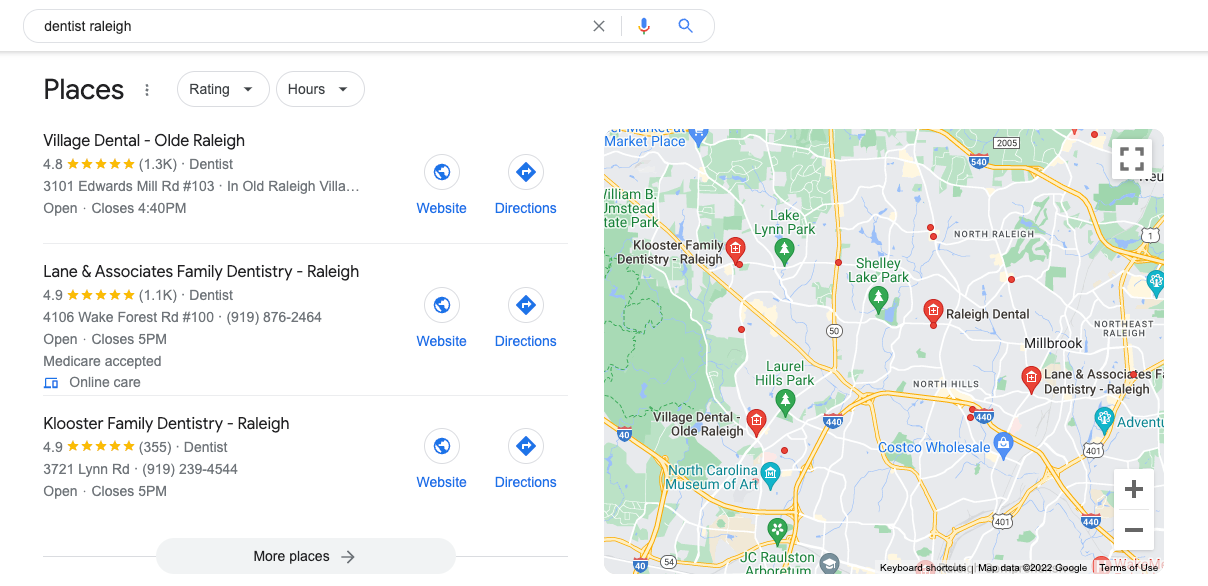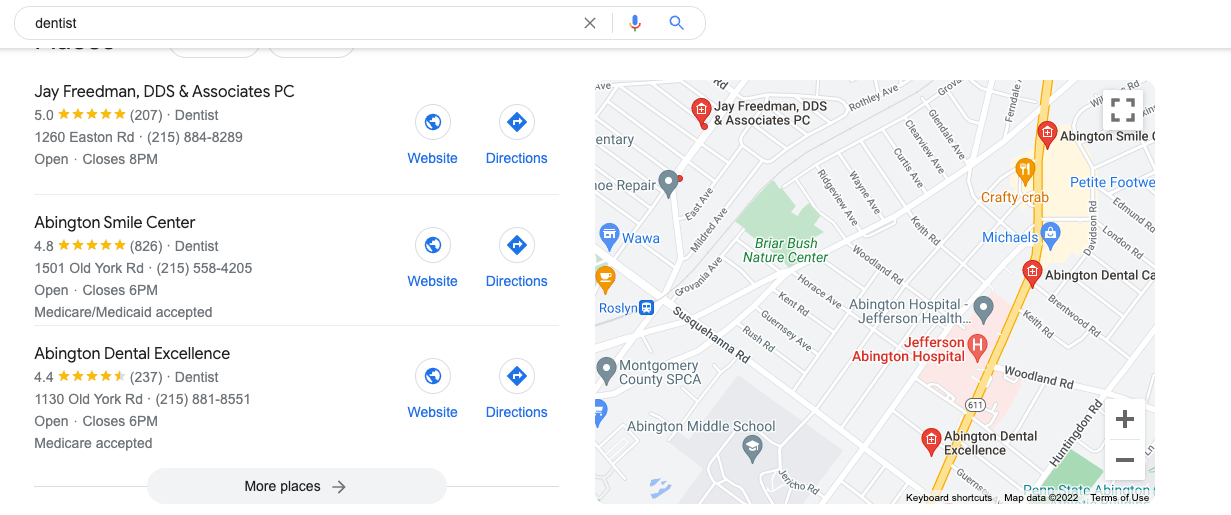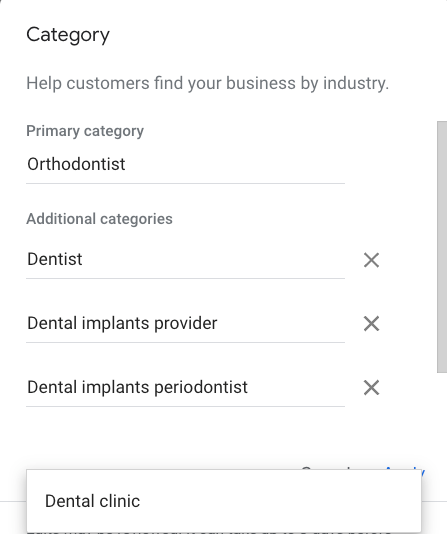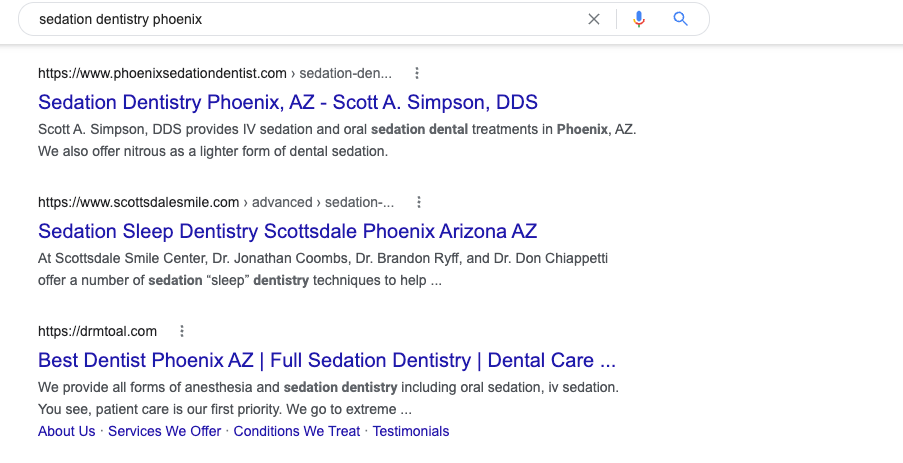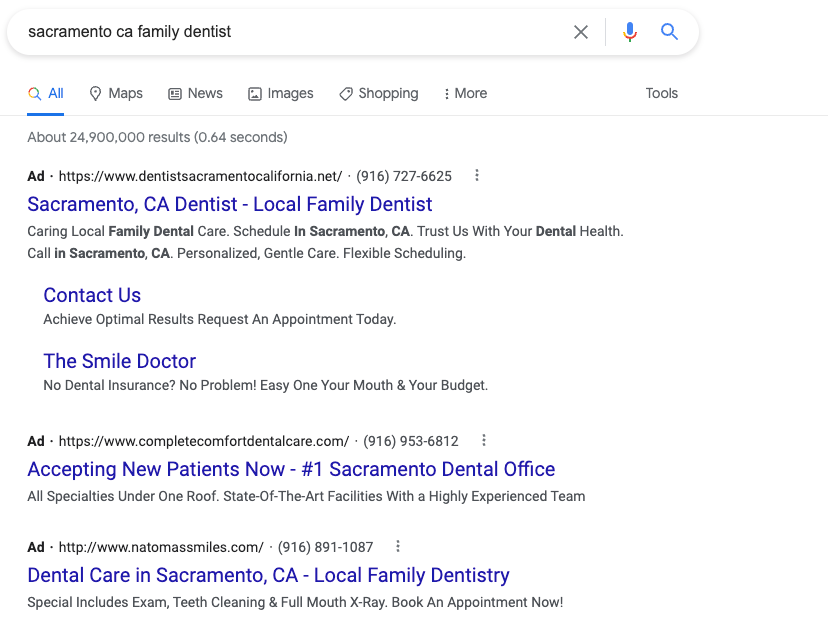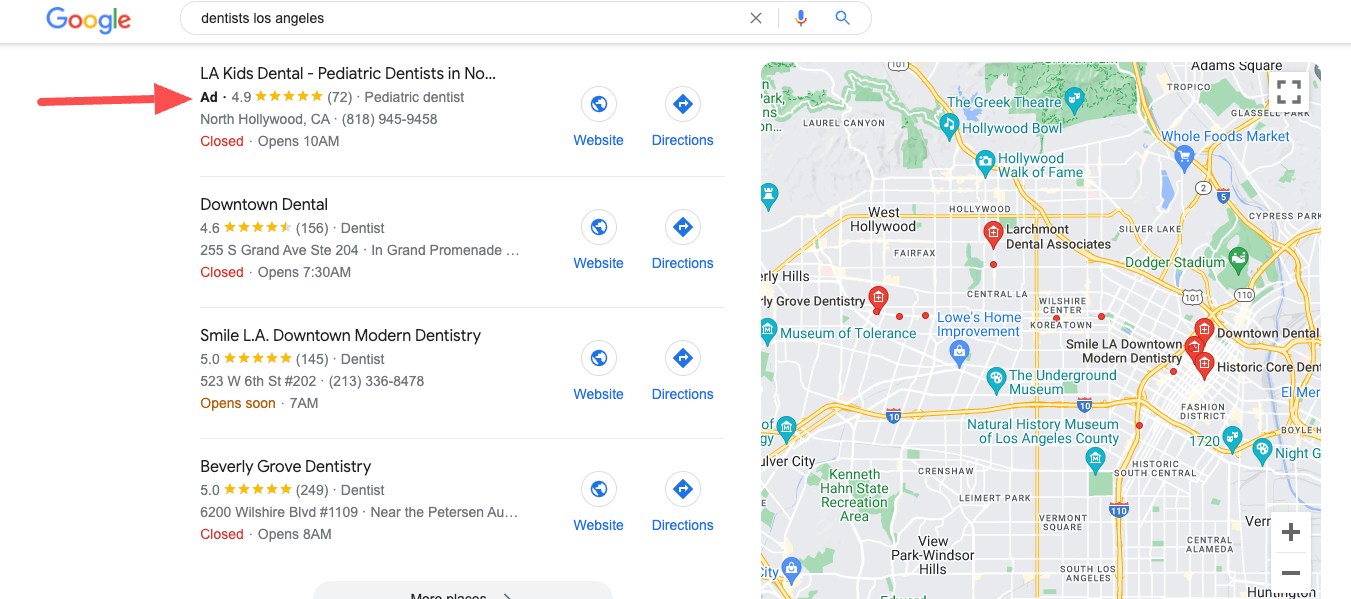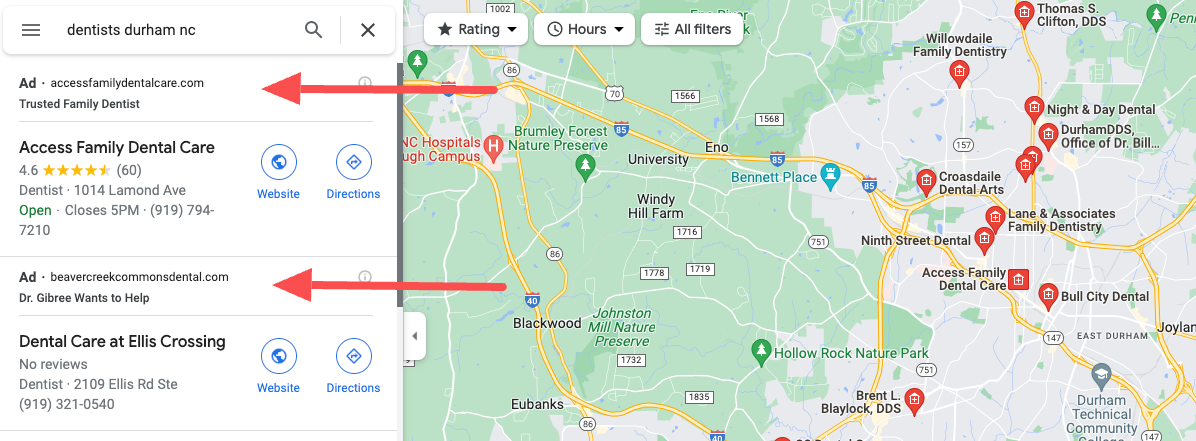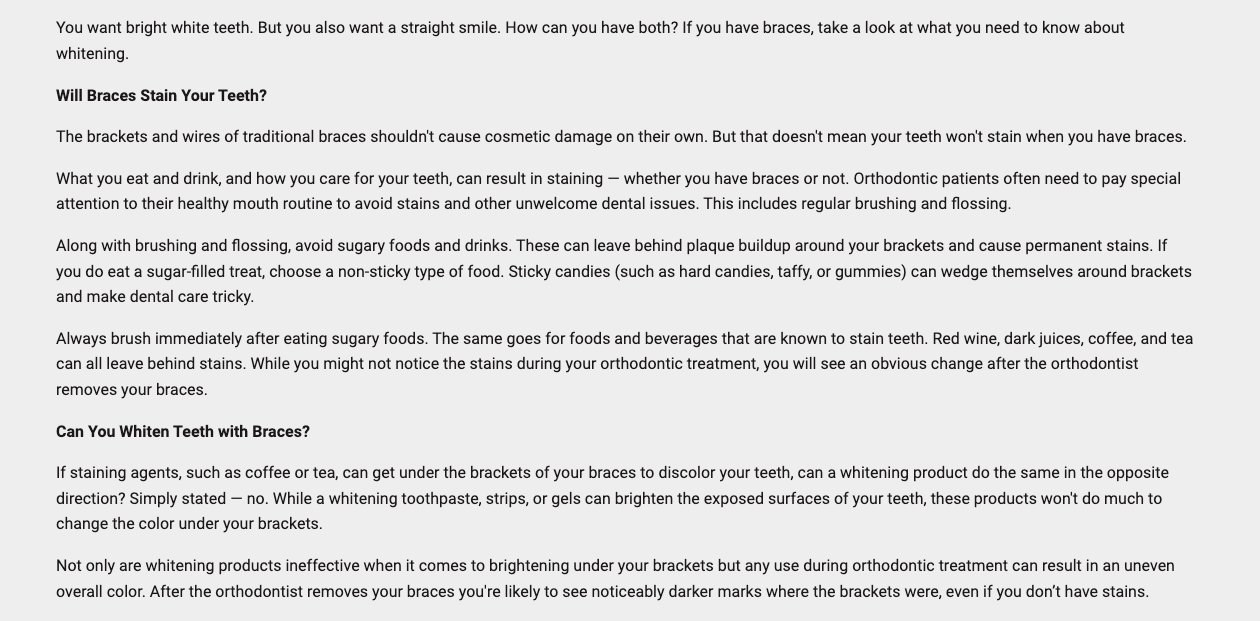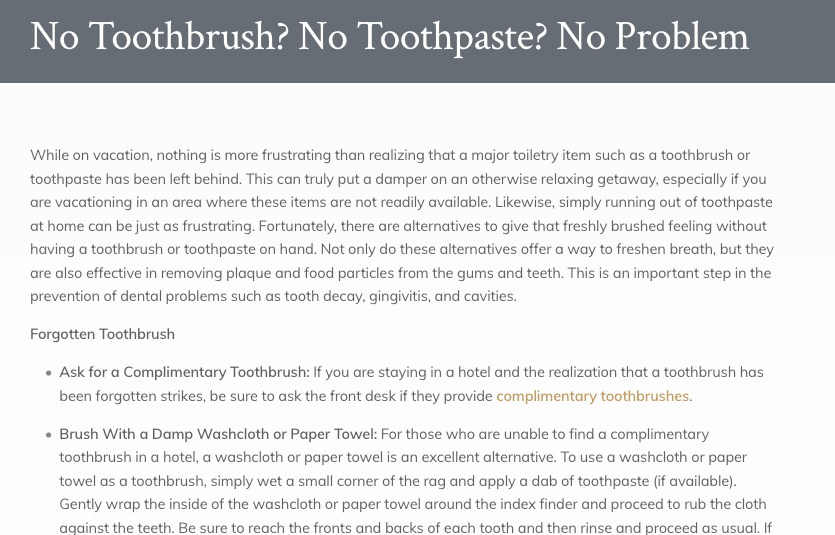Table of Contents
It can be overwhelming to consider all the different types of digital marketing strategies for dentists. The number of options available provides a lot of opportunities to promote your business but also an impossible number of different methods to test.
Related Content:
Fortunately, at Go Fish Digital we have a lot of experience in providing digital marketing support for the dental community. While there are many different digital marketing channels that you can use, there are some that are a particularly good match for the localized nature of dental businesses.
What Are The Best Digital Marketing Strategies For Dentists?
The best digital marketing strategies for dentists are:
- Local SEO
- Traditional SEO
- Google Search Ads
- Local Search Ads
- Content Marketing
- Email Marketing
- UX Improvements
- Reputation Management
Below you can find more information on each one.
1. Local SEO For Dentists
In dentist digital marketing, one of the most important areas of SEO is the “map pack” results that you see in Google’s search results. These are a type of local SEO result that you see when searching for businesses that serve a particular geographical area. Oftentimes, you’ll see these results when you search for keywords that contain geographical information (city/town/neighborhood) or when users query terms like “near me”.
However, this isn’t the only time when Google will show local results. Even broader keyword searches will show them. Take this example of a search for “dentist” where you can see Google displaying dental practices in the immediate area.
This is because even though the geography isn’t specified, Google implicitly understands that users are looking for local businesses to solve a local need. Therefore, the search engine only shows results in that particular area.
This is an extremely powerful concept for dental businesses to understand. This means that your company could appear for very broad keywords such as “dentist” or “cosmetic dentist” in your local geography. In order to improve the chances that your business appears in these results, you’ll want to be sure that you’re implementing local SEO best practices. While there are a variety of strategies here, one of the best ones that you can implement is claiming and optimizing your Google Business profile.
Google Business Profile Optimization
Your Google Business profile is the single most important element of your dental local SEO strategy. Without one, your business won’t be eligible to appear in the map pack results.
The first step you should take is to claim your Google Business profile. To start this process, you’ll simply:
- Search for your practice name on Google Maps
- If you find your business address, you’ll select it and choose “Claim this business”
Once you’ve claimed your business, your next step is to ensure that you’ve properly set your business categories. If you don’t set your categories, you won’t be eligible to appear in the local results for keywords related to those categories. You’ll want to be sure that this is filled out as thoroughly as possible.
Here you can see categories set for an orthodontist business that also provides dental implants.
While the categories that you set will be completely custom to your business, here are some popular ones that you could consider choosing from:
- Dentist
- Cosmetic dentist
- Pediatric dentist
- Dental implants provider
- Dental clinic
- Orthodontist
- Dental hygienist
- Emergency dental service
Doing these steps to claim and optimize your Google Business profile will set you on a good path to ensuring that you have a strong local SEO foundation. Of course, you may need to take this even further and work on generating citations, reviews and local backlinks to your website.
2. Standard SEO
When performing dental digital marketing, you’ll also want to take steps to improve the “standard SEO” of your site. Here, “standard SEO” just means any results in Google that aren’t part of the “map pack listings”. These results won’t have an interactive map or business location pins.
Instead, they’ll look more like the default search results that you’re used to seeing.
These results aren’t influenced by the information in your Google Business profile or other signals like proximity to users. Instead, these results are more based on universal SEO principles such as quality of content, relevant landing pages and internal/external linking signals.
While there are many elements that need to be reviewed from an SEO perspective, one of the best initiatives that your dental practice can take is to ensure that you have dedicated landing pages for all the services that you offer. If your practice offers dental implants, sedation dentistry, and teeth whitening, you’ll want to be sure that you have dedicated pages for each service.
This will ensure that your site has specific pages mapped to your practice areas. Now these pages will be eligible to appear for high intent queries such as “dental implants near me”. Ensure that you inventory all your core services and ensure there’s a matching landing page for each one.
3. Google Search Ads
While SEO initiatives are an extremely lucrative way of improving your dental digital marketing in the long term, it can take time to see results. If you’re looking for immediate return, paid media advertising could be a good path for your practice. With advertising you’ll pay for prominent placements directly but will start seeing results as soon as your campaign begins.
One of the most popular forms of advertising is Google Ads search campaigns. With search campaigns, your practice has the ability to appear at the very top of the search results. Here you can see an example of Google ad results for the keyword “sacramento ca family dentist”
The most powerful feature of Google search ads is that you can choose exactly which keywords you want your results to appear for. For instance, if you want your dentistry to grow more clients for “Dentures” and “Sedation”, you can create campaigns where your results will only appear when users search for keywords related to those practice areas.
With search ads, you’ll be able to leverage the popularity of Google’s ad platform to drive traffic to the exact pages that you want. This helps you connect with customers at the exact moment that they’re looking for your services.
4. Local Search Ads For Dentists
Another way to enhance your dentistry’s digital marketing is to advertise directly on Google Maps using Local Search Ads. By utilizing local search ads, your ads are more integrated into the Google maps experience. This further encourages users to take vital actions such as making calls, requesting appoints or getting driving directions to your office.
Local search ads can often appear at the very top of the map pack, directly above the organic listings.
They can also appear directly in the Google Maps interface as users are scanning a very specific geographic area.
Local search ads will be dedicated by the optimization of your Google Business profile. Before starting them, ensure you followed the steps in the “Google Business Optimization” section to ensure that you have claimed and set all relevant categories for your local business page.
5. Content Marketing
Content marketing is another dental digital marketing strategy that your practice should consider.
Broadly, the premise behind content marketing is to create helpful and educational online resources. These resources help educate and solve the problems you users have, increasing their touch points and affinity for your brand. Over time, content marketing initiatives can help your company be the one that comes to mind when consumers of that content are eventually ready to become customers.
While content marketing can come in many forms, a blog is by far the most popular method. Here, you can write about your solutions to common customer problems that may tie back to your services.
For example, Donald Snyder Orthodontics wrote a specific guide on “Can You Whiten Your Teeth While Wearing Braces?”
As a result, this page generates 1,700 sessions a month for users looking for information on how to solve this specific problem.
Here’s another example of a dentist site that wrote an article on “No Toothbrush? No Toothpaste? No Problem“. This article dives into best practices for how to brush your teeth without toothpaste or toothbrushes and gives several helpful examples. As a result, they perform well in the search results for terms such as “brush teeth without toothpaste”.
Ideally, you’ll want to identify types of problems your potential customers are having and create content that helps solve those problems. From there you’ll create assets on your site that you can show prospective customers, can rank in the search engines or be utilized in your other marketing initiatives.
6. Email Marketing
For almost any business, developing an email list can be a great digital marketing strategy. Email marketing provides a lot of benefits that other digital marketing mediums don’t possess. Emails provide direct access to your core customers and your messaging is less likely to get lost in noisy feeds. Emails are also algorithm independent. Your visibility won’t be at the mercy of major tech companies that make changes to how their algorithms work. Email marketing can help you not only connect with new patients but help maintain your relationships with existing ones.
While how you utilize email will depend on your marketing goals, below are some campaigns that you could consider:
- Dental health best practices & tips
- Appointment confirmations & reminders
- Company news
- New service & product announcements
- Internal promotions
- New patient email sequences
If you’re interested in exploring more, Constant Contact has created a great guide for email marketing best practices for dentists.
7. User Experience Improvements
Reviewing the overall user experience of your site is another great digital marketing strategy for dental sites. This is an extremely scalable approach as UX improvements can help bolster the performance of all your channels. Traffic from search engines, advertising platforms, email marketing and other channels can all be positively impacted.
While there are many ways to think about UX improvement, here are some initiatives that you could look into:
- Calls to action: Elements such as “Schedule Appointment” CTAs should be easily accessible and highlighted in the design
- Mobile UX: Can users easily navigate the site and find key information on mobile devices?
- Website navigation: Can users find key information such as insurance, services, photos, payment and more?
- Site performance: Faster performance can result in improved conversions from a digital channels?
- Site imagery: Do your key pages use strong images that clearly demonstrate the content’s value proposition?
- Trust signals: Do you clearly highlight trust signals such as industry certifications, credentials and reputable organizations?
- Competitive reviews: How does your UX compare to key competitors in the same market or even different geographies?
Improving the overall UX can be a fantastic way to improve the quality of each session. In turn, this improves the efficiency and performance of all digital channels that are driving traffic to your site.
If you feel that quite a few significant changes need to be made, you might even consider looking for options to completely redesign the site.
8. Reputation Management For Dentists
As your customers get closer to the point of narrowing in on your dentistry, it’s likely that they’ll perform more research online about your specific brand. They’ll want to find any information they can about other people’s experience with your office in terms of the staff, environment, professionalism, wait times and much more.
Generally, to perform this type of research, users will perform searches related to your company or individual practitioners. This is a critical point in the conversion path and could significantly influence whether a user turns into a long-term patient. You’ll want to be certain that you have a strong online reputation and users are mainly encountering positive information about your business.
For example, a user may have had strong interactions with your website by discovering it multiple times via paid advertising and organic results. However, upon looking further into your business, they may encounter negative results that put them off the path of conversion.
To audit your dentistry’s reputation, perform the following searches on Google:
- Company name
- Dentist names
- Company + reviews
If you’re finding any negative results in those searches, you’ll want to take immediate steps towards improving your reputation.
For example, if you’re seeing Yelp pages with lower than 4 stars, you might consider improving Yelp reviews. If you’re finding negative stories or press around your company, you might even consider options to suppress negative search results.
Its also worthwhile to check your reviews on individual review platforms to ensure that users looking via those methods are seeing positive sentiments about your brand. The most popular platforms for dentists include:
- Yelp
- US News
- Healthgrades
- Sharecare
If you’re seriously undertaking dental digital marketing strategies, don’t underrate this step. Ensure all of your hard work isn’t lost due to reputation issues that users could be finding in the search results.
Search News Straight To Your Inbox
*Required
Join thousands of marketers to get the best search news in under 5 minutes. Get resources, tips and more with The Splash newsletter:
